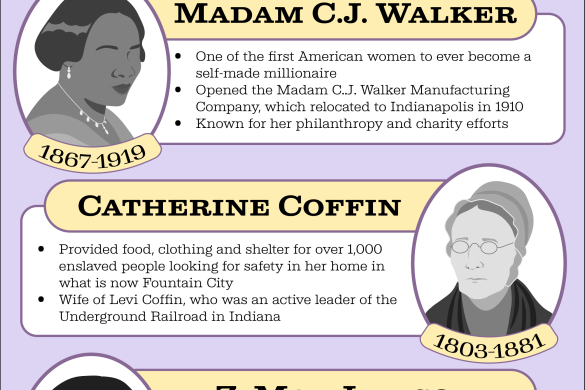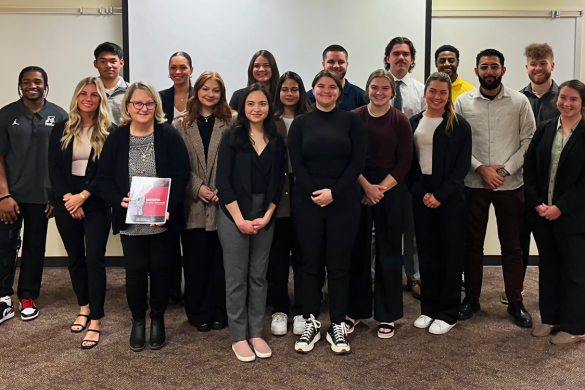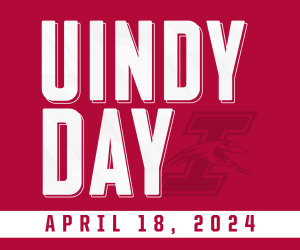
At the Impaired Driving Event, students, like junior communication major Madarrell Murphy (above) wore drunk goggles and attempted to drive a golf-cart through a course and complete a variety of sobriety tests. Photo by BreAnnah Nunn
In hopes of keeping students safe on and off campus the Title IX team put together the Impaired Driving event to teach people about the effects of drinking and driving. The event was held by Director of Student Support and Title IX Coordinator Anne Moelk and Campus Police.
The campus police led the event by running participants through sobriety tests and monitoring them as they drove golf carts through the obstacle course wearing drunk goggles.
According to Moelk, the event was held to encourage students to protect themselves and others around them as part of the protect, advocate, communicate and transform (PACT) aspect of the Title IX program.
“Drinking and driving is not a healthy thing to do,” Moelk said. “We want to make sure people [students] can get an understanding of what it might be like to drink and drive, and realize what a bad choice is it without actually getting injured or arrested.”
According to Campus Police Officer Matthew Mobley, the goal of the event was to teach people to make smart decisions and learn why it is not safe to drink and drive.
“Even though people [students] are laughing at this event, in real life those are not going to be laughs but hurt families and people,” Mobley said. “I think it’s a great program to show people what damages [drinking and driving] can cause.”
The campus police instructed students as they went through various drinking tests wearing goggles of different ranges from under to over the legal drinking limit. The drinking tests were known as sobriety tests and the purpose was to see if the students could pass without receiving a ticket.
According to Mobley the highest tolerance of goggles they provided was .17 percent to .20 percent blood alcohol content, which is about three times the legal limit. The lowest was a .07 percent, which is one below Indiana’s legal limit of .08 percent. Mobley said that students struggled with the lowest set of goggles, which proves that it only takes a little bit of alcohol to cause issues.
Students started at the driving course where they had to drive a golf cart through an obstacle course wearing the goggles. After completing the course, participants were directed to an officer running the sobriety tests. First, they would start off with walking heel to toe in a line, then balancing on one foot until the officer told them to stop. According to junior communication major Madarrell Murphy, he struggled with the course but still enjoyed the event.
“Driving the golf-cart [was] the hardest [and] best part,” Murphy said. “I think it was a fun event. I had on the goggles that were over the legal limit and I couldn’t even see.”
Moelk said that the tests were difficult. She tested the driving course and hit one cone, despite wearing goggles below the legal limit.
“I did the driving test, I passed,” said Moelk. “I was pretty proud of myself but it’s difficult for sure and I think it’s a good lesson for anyone who takes part in drinking and driving.”
According to Mobley, the dangers behind drinking and driving are more severe than they were portrayed during the event. People can lose a lot from just driving under the influence.
“[Students] don’t want that day to come where they regret their decision,” Mobley said. “I’ve had to go to families and let them know that a love one has died because of drinking and driving. They have to go to jail and face that for the rest of their life. They have to sit in a cell and think about that, rather than be free [and] have a career. It’s not worth it.”
Moelk said that it is not in the interest of the school to prevent students from going out but to keep them safe while they are in the school’s care.
“I think making good decisions before you even go out for a night with your friends [is smart],” Moelk said. “Making sure that you have a designated driver or making sure that you have the number for Uber or Lyft. Obviously, the safest would be not to drink at all. I don’t think that necessarily realistic. And for people who are 21 [years old], it’s legal and enjoyable so, I’m not trying to make anyone not have fun. I want to make sure people are being safe with what they are doing.”







